|

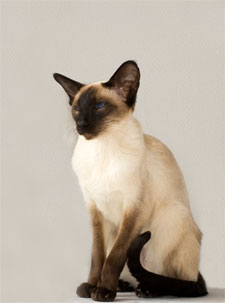 Heated Coats: All Siamese have a creamy base coat with colored points on their muzzles, ears, paws and lower Heated Coats: All Siamese have a creamy base coat with colored points on their muzzles, ears, paws and lower
legs, tails and (in males) scrota. The pointed pattern is a form of partial albinism, resulting from a mutation in tyrosinase,
an enzyme involved in melanin production. The mutated enzyme is heat-sensitive; it fails to work at normal body temperatures, but becomes active in cooler areas of the skin.
This results in dark coloration in the coolest parts of the cat's body, including the extremities and the face, which is cooled by the passage of air through the sinuses. All Siamese kittens, although pure cream or white at birth, develop visible points in the first few months of life in colder parts of their body. By the time
a kitten is four weeks old the points should be clearly distinguishable enough to recognize which color they are. Siamese cats tend to darken with age, and generally adult Siamese living in warm climates have lighter coats than those in cool climates.
An Excellent Wardrobe: Originally Siamese all had seal (extremely dark brown, almost black) points, but occasionally Siamese were born with blue (gray) points, chocolate points, or lilac (pale gray) points, each of which was eventually accepted by the breed associations and allowed to compete in shows. Genetically, blue point 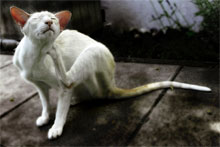 is a dilution of seal point and lilac point a dilution of chocolate point, which is itself a variation of seal point. Later, outcrosses with other breeds developed Siamese cats with points in other cat colors and patterns including red point, lynx (tabby) point, and tortoise-shell ("tortie") point. In the United Kingdom, all pointed Siamese-style cats are considered to be part of the Siamese breed. In the United States, the major cat registry, the Cat Fanciers' Association, considers only the four original colorations as Siamese: seal point, blue point, chocolate point, and lilac point. Oriental cats with colorpoints in colors or patterns aside from these four are considered Colorpoint Shorthairs in the American cat fancy. is a dilution of seal point and lilac point a dilution of chocolate point, which is itself a variation of seal point. Later, outcrosses with other breeds developed Siamese cats with points in other cat colors and patterns including red point, lynx (tabby) point, and tortoise-shell ("tortie") point. In the United Kingdom, all pointed Siamese-style cats are considered to be part of the Siamese breed. In the United States, the major cat registry, the Cat Fanciers' Association, considers only the four original colorations as Siamese: seal point, blue point, chocolate point, and lilac point. Oriental cats with colorpoints in colors or patterns aside from these four are considered Colorpoint Shorthairs in the American cat fancy.
Eye Trouble: Siamese have almond-shaped, bright blue eyes and short, flat-lying 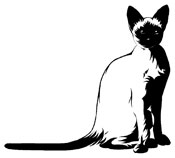 coats. Many Siamese cats from Siam had a kink in their tails but over the years this trait was considered a flaw and breeders have largely eradicated it. Many early Siamese were cross-eyed to compensate for the abnormal uncrossed wiring of the optic chiasm, which is produced by the same albino allele that produces colored points. Like the kinked tails, the crossed eyes have been seen as a fault and through selective breeding, the trait is far less common today. coats. Many Siamese cats from Siam had a kink in their tails but over the years this trait was considered a flaw and breeders have largely eradicated it. Many early Siamese were cross-eyed to compensate for the abnormal uncrossed wiring of the optic chiasm, which is produced by the same albino allele that produces colored points. Like the kinked tails, the crossed eyes have been seen as a fault and through selective breeding, the trait is far less common today.

The Voice: The Siamese voice, which they use frequently, is unlike that of other breeds, and has been compared to the cries of a human baby. As they are "wired for sound," they can meow loud enough to compete with fire and rescue equipment. The Siamese temperament is legendary: like all Oriental cats Siamese are active, playful, extremely vocal and persistent in demanding attention. They usually get on well with other cats, especially other Siamese or related breeds, but they also have a great need for human companionship and often will engage in crazy antics to get the attention of their people. Siamese cats are generally believed to be highly intelligent, and their behavior usually reflects this. Siamese are often described as "dog-like" because of their loyalty, often attaching themselves to one human in a household, and their trainability--they can be taught to walk on a leash, fetch and perform tricks.

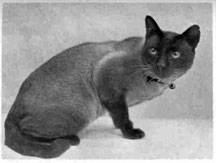 A Whole New World: The breed was first seen outside their Asian home in 1884, when the British Counsul-General in Bangkok, Mr. Owen Gould, brought a pair of the cats back to Britain for his sister, Mrs. Veley (who went on to be co-founder of the Siamese Cat Club in 1901). The cats were shown at the Crystal Palace in 1885, and the following year another pair (with kittens) were imported by a Mrs. Vyvyan and her sister. Compared to the British Shorthair and Persian cats that were familiar to most Britons, these Siamese imports were somewhat longer and less "cobby" in body, had heads that were less round and larger ears. These differences and the pointed coat pattern which had not been seen before by Westerners, produced a strong impression--one early viewer described them as "an unnatural nightmare of a cat!" But these striking cats also won some devoted fans and over the next several years fanciers imported a small number of cats, which together formed the base breeding pool for the entire breed in Britain. It is believed that most Siamese today are descended from about eleven of these original imports. A Whole New World: The breed was first seen outside their Asian home in 1884, when the British Counsul-General in Bangkok, Mr. Owen Gould, brought a pair of the cats back to Britain for his sister, Mrs. Veley (who went on to be co-founder of the Siamese Cat Club in 1901). The cats were shown at the Crystal Palace in 1885, and the following year another pair (with kittens) were imported by a Mrs. Vyvyan and her sister. Compared to the British Shorthair and Persian cats that were familiar to most Britons, these Siamese imports were somewhat longer and less "cobby" in body, had heads that were less round and larger ears. These differences and the pointed coat pattern which had not been seen before by Westerners, produced a strong impression--one early viewer described them as "an unnatural nightmare of a cat!" But these striking cats also won some devoted fans and over the next several years fanciers imported a small number of cats, which together formed the base breeding pool for the entire breed in Britain. It is believed that most Siamese today are descended from about eleven of these original imports.
New Blood: The original Siamese imports were medium-sized, rather long-bodied, muscular, graceful cats with moderately wedge-shaped heads and ears that were comparatively large but in proportion to the size of the head. The cats ranged from rather substantial to rather slender but were not extreme in either way.
Family Feud: In the 1950s - 1960s, many breeders and cat show judges began to favor the more slender look and as a result of generations of selective breeding, created increasingly long, fine-boned cats; eventually the modern show Siamese was bred to be extremely elongated, with thin, tubular bodies, long, slender legs, a whip-thin tail and long, narrow, triangular-shaped heads topped by extremely large 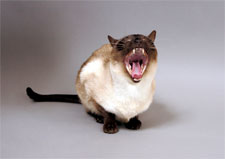 ears. The major cat organizations altered their official breed standards to favor this newer streamlined type of Siamese, and the minority of breeders who stayed with the original style found that their cats were no longer competitive in the show ring. By the mid-1980s, cats of the original style had disappeared from cat shows, but a few breeders continued to breed and register them, resulting in two types of purebred Siamese – the modern show Siamese, and the "traditional," or "Apple Head" Siamese, both descended from the same distant ancestors, but with few or no recent ancestors in common. In the late 1980s, breeders and fans of the older style of Siamese, concerned that the old lines were threatened with extinction, organized to preserve them, to educate the public about the breed's history and to provide information on where people could buy kittens of the more moderate type, which became known primarily as "Traditional Siamese". ears. The major cat organizations altered their official breed standards to favor this newer streamlined type of Siamese, and the minority of breeders who stayed with the original style found that their cats were no longer competitive in the show ring. By the mid-1980s, cats of the original style had disappeared from cat shows, but a few breeders continued to breed and register them, resulting in two types of purebred Siamese – the modern show Siamese, and the "traditional," or "Apple Head" Siamese, both descended from the same distant ancestors, but with few or no recent ancestors in common. In the late 1980s, breeders and fans of the older style of Siamese, concerned that the old lines were threatened with extinction, organized to preserve them, to educate the public about the breed's history and to provide information on where people could buy kittens of the more moderate type, which became known primarily as "Traditional Siamese".
There are several other cat breeds derived from the Siamese. These include:
Balinese – a longhaired Siamese. In the largest US registry, the Cat Fanciers Association (CFA), limited to the four traditional Siamese coat colors of seal point, blue point (a dilute of seal point), chocolate point and lilac point (a dilute of chocolate point). Other registries in the US and worldwide recognize a greater diversity of colors.
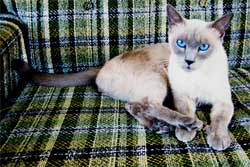 Burmese – a breed of domesticated cats descended from a specific cat, Wong Mau, who was found in Burma in 1930 by Dr. Joseph G. Thompson. She was brought to San Francisco, California, where she was bred with Siamese. While technically not derived from Siamese, the breed was considered to be a form of Siamese for many years, leading to cross-breeding. Burmese – a breed of domesticated cats descended from a specific cat, Wong Mau, who was found in Burma in 1930 by Dr. Joseph G. Thompson. She was brought to San Francisco, California, where she was bred with Siamese. While technically not derived from Siamese, the breed was considered to be a form of Siamese for many years, leading to cross-breeding.
Colorpoint Shorthair – a Siamese-type cat registered in CFA with pointed coat colors aside from the traditional CFA Siamese coat colors; originally developed by crosses with other shorthair cats. Considered to be part of the Siamese breed in all other cat associations, but considered a separate breed in CFA. Variations can include Lynx Points and Tortie Points.
Himalayan - Long-haired breed originally derived from crosses of Persians to Siamese and pointed domestic longhair cats in order to introduce the point markings and the colors chocolate and lilac. After these initial crosses were used to introduce the colors, further breed development was performed by crossing these cats only to the Persian breed. In Europe they are referred to as colorpoint Persians. In CFA they are a color division of the Persian breed.
Javanese – a longhaired version of the Colorpoint Shorthair in CFA. In Europe, an obsolete term for the longhaired version of the Oriental Shorthair.
Ocicat – a spotted cat originally produced by a cross between Siamese and Abyssinian.
Oriental Shorthair – a Siamese-style cat in non-pointed coat patterns and colors, including solid, tabby, silver/smoke, and tortoise-shell.
Oriental Longhair – a longhaired version of the Oriental Shorthair.
Serengeti Cat – a spotted breed created to resemble the Serval, from Siamese, Oriental Shorthair, and Bengal crosses.
Tonkinese – a cross between a Siamese cat and a Burmese. The Tonkinese are "pointed" cats but their bodies are of a darker color than the Siamese.
-----------------------------------------------------------------------------------------------------------------------------
Siamese Stars: The Siamese cat breed is one of the most famous and beloved. They have a knack for appearing with celebrities and showing up on films. Some of the best known Siamese cats include:
* Bucky Katt from Get Fuzzy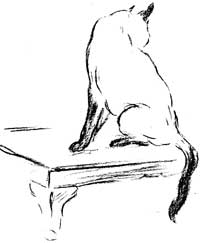
* Genghis - Growltiger's enemy in Old Possum's Book of Practical Cats by
T. S. Eliot
* Jason - Seal-point on BBC TV's Blue Peter
* Koko & Yum-Yum - from Lillian Jackson Braun's "The Cat Who..." novels
* Misty Malarky Ying Yang, pet of Amy Carter
* Pyewacket, the witch's familiar in the
film Bell, Book and Candle
* Tao, from Sheila Burnford's novel The Incredible Journey
* Sagwa in the children's book Sagwa, the Chinese Siamese Cat by Amy Tan and animated TV series of the same name
* Shan Shein - White House cat owned by Gerald Ford's daughter, Susan
* Si and Am from Lady and the Tramp
* Syn, who played the title role of "D.C." in the 1965 Walt Disney film That Darn Cat!
* Kit the Cat, the "familiar spirit" of the main characters in Charmed
* Solange from 9 Chickweed Lane
All text is available under the terms
of the GNU Free Documentation License
|
